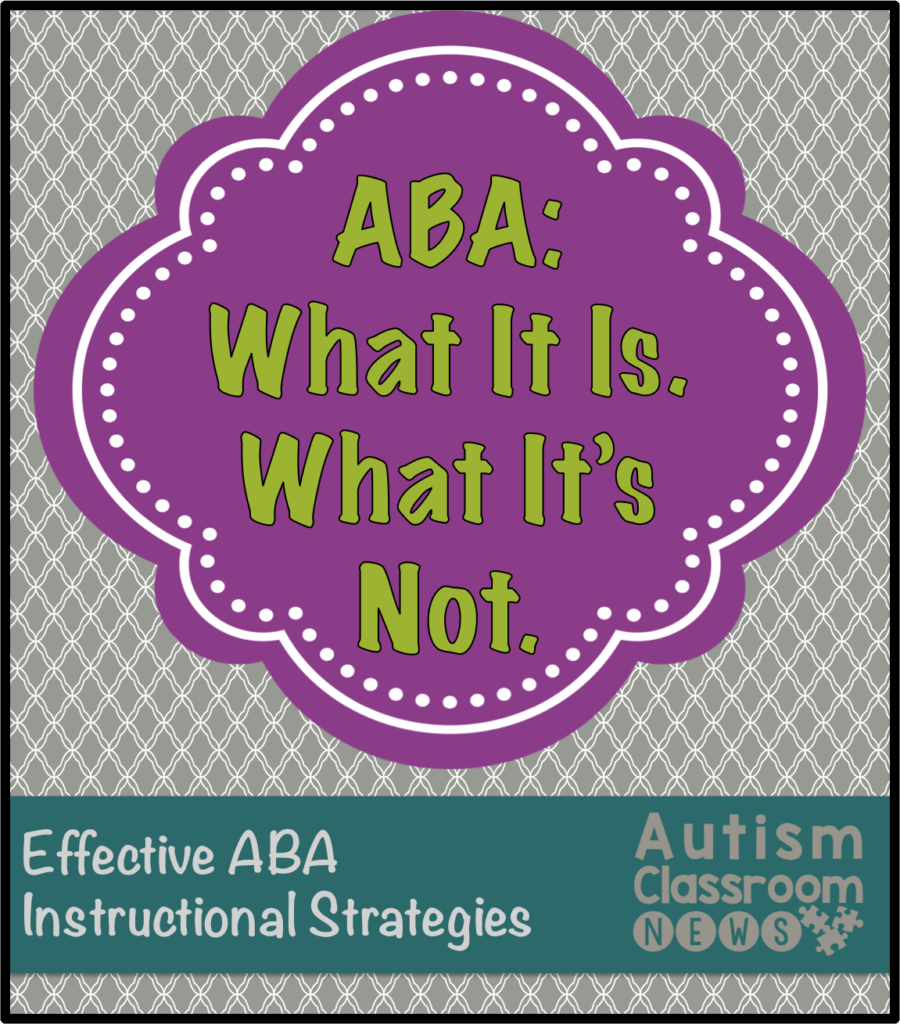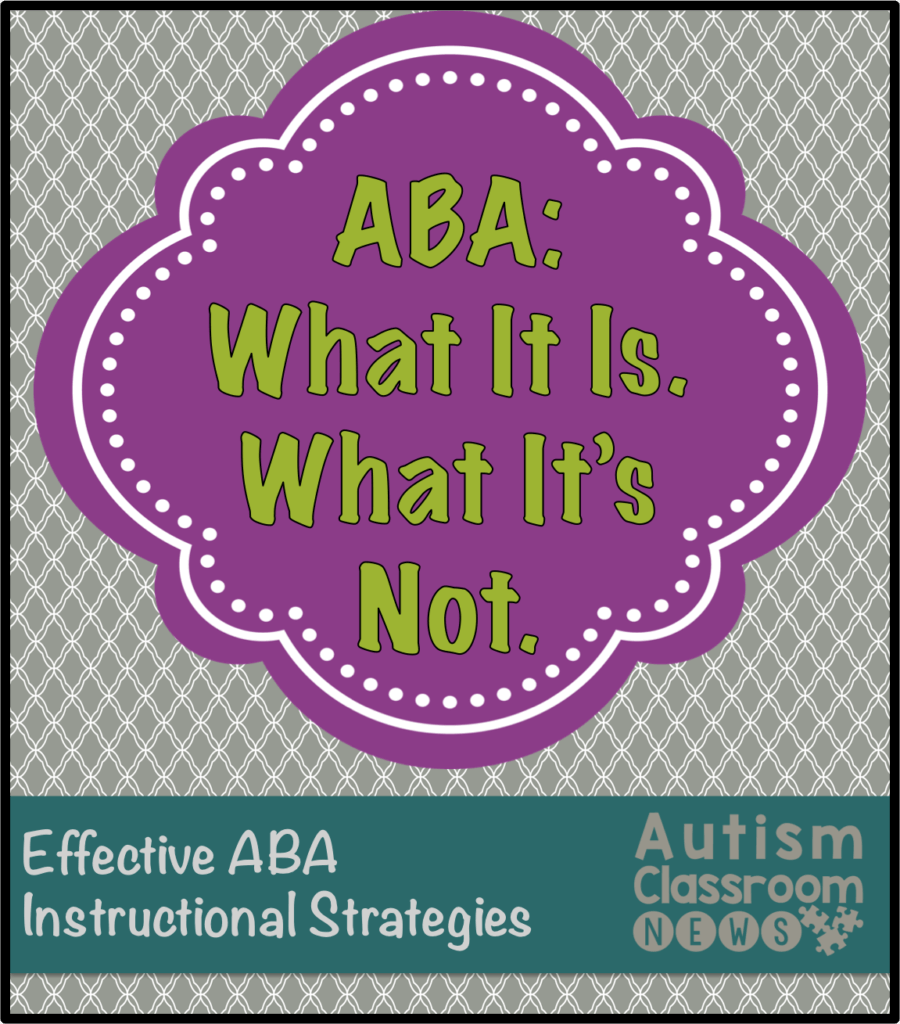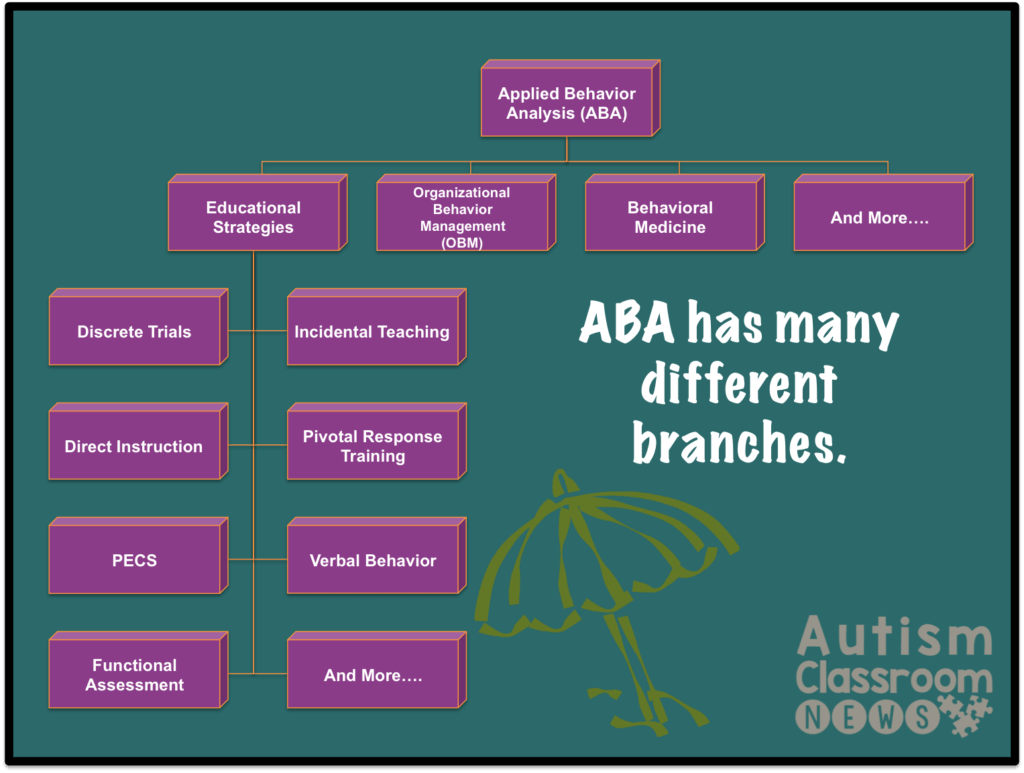Sharing is caring!
 When you review evidence-based practices for individuals with ASD, the category of interventions that has the largest evidence base is applied behavior analysis (ABA). This is because ABA strategies are very effective and also because it’s a science built on data and research.
When you review evidence-based practices for individuals with ASD, the category of interventions that has the largest evidence base is applied behavior analysis (ABA). This is because ABA strategies are very effective and also because it’s a science built on data and research.
ABA has grown in popularity, especially in the field of autism, in the last 20 years so most people have now heard of it. So it still surprises me that so many people have so many misconceptions about what ABA is. When I started in this field, all too many years ago, it wasn’t at all surprising that people didn’t know what ABA was. But it’s interesting to me how the myths and misconceptions of it continue to persist given how much we know about working with students with autism now.
So, I wanted to do a series on instructional strategies and focus on some of the newer research looking at how we present instruction to be most effective with students with autism and decided it should start with a clear discussion about what ABA is….and what it isn’t. This won’t be every misconception, and some of them I’ll deal more with in later posts, but I thought an introduction would be helpful to start off.
What ABA IS.
ABA is the science of behavior as it applies to socially significant issues.
That means it’s BIG. It goes well beyond education. You can see from the chart below that there are many applications in education as well as organizational behavior analysis (that focuses on behavior in industry and organizations), behavioral medicine and others. Within education it covers the approach for reducing challenging behavior through functional assessment as well as a variety of instructional strategies.
ABA is a science that is applied to real-life problems.
It is evidence-based and it is based on and steeped in research. All certified behavior analysts are required to take course work in research designs that can be implemented in clinical practice. We are trained in data collection and analysis and are ethically required to make our decisions about intervention based on research as well as the individual learner’s data. This is one of the reasons why ABA has the most research supporting it among autism interventions–the research is built into the process of practice.
ABA is based on observable behavior
Behaviors we can see, we can measure. Behaviors we can measure, we can scientifically change and assess. Behaviors we can’t see we don’t have much control over. As I talked about the challenging behavior series, when we look at behavior we have to focus on what we can see. Things we can’t see we are guessing about. We change the environment to change the behavior. The key is in the relationship between the environment (that exists or that we create) to elicit or reduce a behavior or a skill.
What ABA is NOT
ABA is NOT just for autism.
Most people who have heard of ABA have learned about it in relation to autism and sometimes in more general developmental disabilities. This is an area of the science that has really grown in the last 20 years since the publication of Ivar Lovaas’ study using discrete trials with very young children with ASD in the 1980s. It’s an area that now is accepted as one of the most evidence-based approaches for instruction, particularly for young children. Probably 80 to 85% of the practitioners in ABA are working with autism or related disabilities. However, ABA is used all the time with typical children, with adults, to change parenting behavior, to change society’s behavior (like increasing seatbelt use and recycling), and many other applications.
ABA is JUST using discrete trials
Um, no. Just no. This is probably what most people have had experience with but it most definitely is NOT the extent of how we can use ABA even within the autism field. Discrete trials are ONE tool in the ABA basket, but it’s not the extent of instruction. If you have ever used Reading Mastery (the SRA programs for teaching reading) you have used ABA–direct instruction is based on ABA. ABA includes many naturalistic approaches to teaching such as Pivotal Response Training (PRT) and incidental teaching. If you have had training in discrete trials, you have had training in ONE tool from ABA. I will talk extensively about discrete trials in future posts and it is a very useful tool, but it’s not the only one you need for effective instruction.
ABA is one size fits all
This one flummoxes me. One of the thing I love about ABA is that it is highly individualized and decisions are made based on the performance of the learner. And yet I continually meet people who have been trained that you “have” to do instruction this one way. Is there best practice in the way we approach things? Of course, but it’s a lockstep first do X then do Y whether student is progressing or not. If the student isn’t learning, we stop doing what we have been doing and problem solve and change it to help him learn.
ABA makes students dependent upon bribery or treats
This one makes me crazy. We use reinforcers in ABA to increase behavior. Reinforcers are much more complex than “treats” or bribes, as you can read HERE and HERE among others. Part of using reinforcers is to fade them effectively. The whole goal of using them is to stop using them over time. We have specific procedures for fading them and reducing their use over time. I’ll talk more about this process over the course of this series.
ABA forces children to do things that are unnatural.
Let me just say, any intervention can be done badly. ABA done badly is not real ABA. One of the big controversies recently is the use of ABA to force kids to make eye contact. Many self-advocates with autism talk about their very negative experiences with earlier versions or poorly implemented (in my mind) ABA approaches that required eye contact. This isn’t good practice. Does ABA try to change behavior….yes, so does teaching…that’s what teaching does. However, the skills you teach are governed based on curricula and should be part of a team decision whether it’s a treatment plan or an IEP. I would say that in the last 15 years we (I) have learned a lot about what’s important to teach and what’s not. The approach to teaching eye contact and other skills has changed significantly as the field has evolved. The long and short is that if something you are trying to teach is getting lots of resistance, it’s the instructor’s responsibility to figure out why and decide whether the instruction should change. Fighting the behavior isn’t teaching a skill. It’s a power struggle. Power struggles are not instructive. I’ll talk more about all of this when I talk about discrete trials.
So, those are just some of the myths I’ve encountered over time about ABA. There are even more about discrete trials that I will cover in future posts. What are your ideas about ABA? Share them in the comments and we can address them. I’ll be back in the next few posts talking about deciding what to teach and some curricula and then some of the research about instructional elements. If you have questions you would like answered, please share them and I’ll try to address them.




![Summer resources to help survive the end of the year in special education [picture-interactive books with summer themes]](https://autismclassroomresources.com/wp-content/uploads/2018/05/SUMMER-RESOURCES-ROUNDUP-FEATURE-8528-768x768.jpg)




